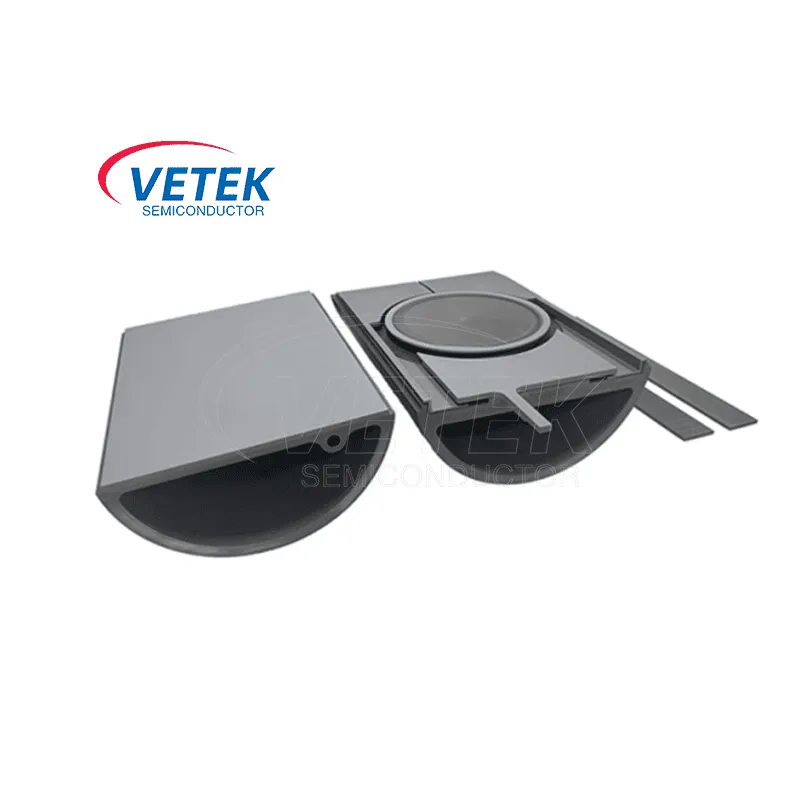The Process and Benefits of SiC Coating for Halfmoon Graphite Parts
2024-10-24
When it comes to improving the performance of graphite components, particularly those shaped in the distinctive halfmoon form, Silicon Carbide (SiC) coating is one of the most effective methods. Graphite, known for its high thermal conductivity and mechanical strength, can further benefit from SiC's exceptional wear resistance and oxidation protection. This blog will take you through the SiC coating process for halfmoon graphite parts and highlight the benefits of this advanced technology.
The Process of SiC Coating on Graphite
The process of applying Silicon Carbide coatings on graphite typically involves chemical vapor deposition (CVD). This method is favored for its ability to create a uniform, high-purity SiC layer over complex shapes like halfmoon graphite parts. Here’s an overview of the steps involved:
1. Surface Preparation: The graphite part is cleaned and prepared to ensure the SiC coating adheres properly. This may include physical or chemical treatments to remove impurities or roughen the surface slightly.
2. Chemical Vapor Deposition (CVD): In this process, gases like methyltrichlorosilane (MTS) are introduced into a heated chamber containing the graphite part. At high temperatures, these gases decompose and deposit a solid layer of SiC onto the graphite surface. The CVD process ensures the coating is dense, uniform, and adheres strongly to the base material.
3. Cooling and Finishing: Once the coating is applied, the part is cooled, and any necessary post-processing, such as polishing or inspection, is performed to meet quality standards.
Key Benefits of SiC Coating on Halfmoon Graphite Parts
The application of SiC coating on halfmoon graphite parts brings several distinct advantages to their performance and longevity:
1. Oxidation Protection: Graphite has a high susceptibility to oxidation, especially at temperatures exceeding 500°C. The SiC coating creates a protective barrier, allowing these parts to function effectively in high-temperature environments without deteriorating.
2. High Thermal Stability: Silicon Carbide coatings are stable at extremely high temperatures, up to 2,000°C, which makes them ideal for use in demanding applications such as metal casting, high-temperature furnaces, and semiconductor processing.
3. Resistance to Chemical Degradation: In environments where the part is exposed to harsh chemicals, SiC coatings offer excellent protection. This is particularly useful in industries like chemical processing or photovoltaic manufacturing, where corrosive gases are common.
4. Wear Resistance: One of the most important features of SiC is its hardness, which dramatically increases the wear resistance of coated graphite parts. This makes the parts more durable, even in environments where they are subject to high mechanical stress or abrasive materials.
5. Enhanced Performance in Extreme Environments: SiC-coated halfmoon graphite parts perform better in both vacuum and high-pressure environments, making them useful in aerospace, energy, and semiconductor industries.
Common Applications of SiC-Coated Halfmoon Graphite Parts
- Heat Exchangers and Crucibles: In industries that require high-temperature processes, such as glass manufacturing or metallurgy, SiC-coated graphite parts are used for their durability and ability to withstand extreme heat.
- Semiconductor Equipment: The semiconductor industry relies heavily on SiC-coated graphite parts due to their resistance to the harsh, reactive chemicals used in wafer production processes like etching and chemical vapor deposition.
- Solar and Renewable Energy: As the demand for renewable energy grows, so does the need for high-performance materials. SiC-coated halfmoon graphite parts are being employed in the manufacturing of solar cells, fuel cells, and other energy applications due to their thermal and chemical properties.
The application of Silicon Carbide (SiC) coatings on halfmoon graphite parts provides unparalleled protection and performance in harsh environments. Whether it’s for high-temperature processes, exposure to corrosive chemicals, or wear resistance, the combination of graphite’s natural properties with SiC’s robust coating ensures that these components deliver optimal results in even the most extreme industrial conditions. For industries pushing the boundaries of temperature, stress, and chemical exposure, SiC-coated graphite parts offer a proven, reliable solution.



